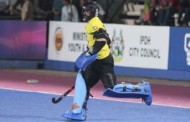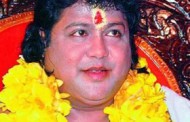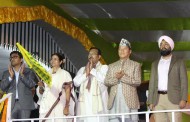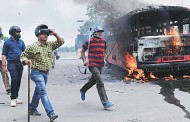Mumbai, Aug 27 (PTI) In keeping with the spirit of the Indian Handloom & Textile day at Lakme Fashion Week, designers Swati and Sunaina, Rinku Sobti, Shruti Sanchet, and Swati Vijaivargaie along with Bollywood actresess Gauhar Khan, Lisa Haydon, Vidya Malwade today celebrated the rich heritage of hand-woven luxury.
The weaves of Banaras are the only surviving textiles in the world and the platform of the fashion week proved to be a perfect meeting point of the age-old traditions of the weavers and the high fashion designs.
Ardent followers of finely woven fabrics, Swati and Sunaina have worked with master weavers of Banaras to create heirlooms and keep the art alive.
They said their aim is to design gorgeous traditional textiles that can cater to the desires of the younger generation of sari wearers.
Their experiments with motifs, colours and placements have given a fresh impetus to the fabulous Banaras weaves.
“Our collection is about the intrinsic technique of very sound weaves. Throught this line we have tried to get the weaver, who have been long forgotten to the front seat and try and given them their due. We have showcased a lot of fine sarees,” Swati and Sunaina said.
For Delhi-based Sobti, the chance to remember the weavers was a welcome challenge which she accepted with both arms open.
Bringing to centre stage the intricate work of the weavers in the Bajardiya cluster, the designer’s “Tassels” collection was a ode to beauty. Just like the tufts of pretty free hanging threads or cords that embellish fabrics, the tassels added rich extravagance to the fabulous weaves.
“I have done a lot of checks and have worked very closely with Banarasi weavers. I have used a lot of silk, nets. My collection may consist of a lot of weaves but the style, cuts and silhouettes are such that it will appeal to the younger generation as well,” Sobti told PTI.
Her muse Gauhar said it was an honour for her to walk the ramp for a cause, which is very relevant in today’s times.
“Rinku’s collection is all about tradition and fashion.
The designs are very young and you can wear these garments with ease to any occasion you want- be it parties, weddings or for work as well,” said the actress, who wore a tasselled cropped top and black silk embellished lehenga. .
New Delhi, Aug 27 (PTI) Hockey team goalkeeper PR Sreejesh feels India need to go through tough tests against top teams to excel in next year’s Rio Olympics.
Sreejesh dedicated his Arjun award to the whole team, and said his recognition will motivate he and his teammates to do well in upcoming tournaments.
“This is not my award, this belongs to the whole team.
Hockey is a team game and I alone cannot bring medal for the country. It is a huge honour and responsibility as well and we will be motivated to do well in future tournaments,” Sreejesh told PTI Bhasha.
“We are ranked 8th in the world and one should not expect us to be a world champion overnight. But yes this team has potential and we can beat any team on our day. No team is invincible in modern hockey and we have beaten teams like Australia, New Zealand.
“All we need is to gain more and more experience and tests against top teams. We need to fine tune our game like taking correct decisions in crucial moments to maintain the consistency level and must handle the pressure well. We must not succumb under the pressure of big matches. This will come with experience of playing more against big teams,” he said.
The experienced goalkeeper from Kerala, who has played 121 international matches for India, feels it was advantageous for India to qualify early for the Rio Games but they need to improve further to come up with better results in the mega-event.
India will tour New Zealand for a Test series next month while host Australia in October-November. They will also feature in the Hockey World League Finals later this year in Raipur.
Asked if the off-field controversies, including the unceremonious exits of chief coach Terry Walsh and Paul Van Ass have affected the team, Sreejesh replied replied in the negative.
“Players are matured enough to not get affected by off-field events. We are focusing of our on-field performance only as we all know how important Olympics is for us. This team is together for almost last two years and bonding well which will augur well in our favour,” said the 27-year-old.
He idolises former India goalkeeper Adrian D’souza and feel shy when people call him ‘the wall of Indian hockey’.
“Since the beginning of my career, I have been hearing Rahul Dravid is the wall of Indian cricket. I feel humbled and honoured when people call me ‘the wall of Indian hockey’ now.
It is a huge responsibility,” he said.
Cuttack, Aug 27 (PTI) Allowing a plea of Odisha Police, a court here has ordered the Choudwar jail authorities to make arrangements for video conferencing (VC) to avoid physical production of arrested godman Santosh Roul and his adopted son Satyam in court.
Facing problems in production of the father-son duo in the court and apprehending threat to their lives, the Crime Branch of the police had urged the court to dispense with their physical production and hold the hearing through video conferencing.
The court of sub-divisional judicial magistrate (SDJM) here yesterday accepted the Crime Branch plea and directed the jail authorities to make necessary arrangements for video conferencing.
Both the accused, who are under judicial custody, were directed for appearance in the court on September 2.
Earlier, under heavy escort, the duo were made to travel from jail to court and vice versa. The Crime Branch had also beefed up security in the court premises as mobs were chasing and heckling the alleged fake godman and his son.
Under section 167 of CrPC the accused under judicial custody are to be produced in the court once in every fortnight till the charge sheets are filed
RINGMASTER MAMATA OFFERS CARROT TO GJM SAYS BENGAL WILL DROP 115 CASES AGAINST MORCHA
Writes: Vivek Chhetri
Mamata Banerjee today played the ringmaster of hill politics, announcing a development board for Bhutias and dropping 115 cases against leaders of the Gorkha Janmukti Morcha a little later, which had earlier accused the chief minister of resorting to a divide and rule policy by forming such panels.
Mamata capped the day’s developments by saying she would, for the first time, hold a meeting of the tribal advisory council tomorrow at Lal Kothi, the administrative headquarters of the Gorkhaland Territorial Administration (GTA).
Morcha chief Bimal Gurung, who had postponed his trip to Delhi by two days to welcome the chief minister, sat quietly as the chief minister made the comments.
Aware that the announcement might not go down well with Morcha leaders, Mamata tried to do a balancing act. Soon after the programme, Mamata met a seven-member Morcha delegation, including senior party leaders Roshan Giri, Binay Tamang, Trilok Kumar Dewan and Harka Bahadur Chhetri and announced after the session:
“In the first phase, we have decided to withdraw 115 cases slapped on Morcha leaders and supporters for blocking roads before 2011. We must all work together and we are working together.”
During the tripartite agreement to form the GTA, it had been agreed upon that all cases slapped by the state government on statehood agitators, except for murder, would be withdrawn.
Till today, none has been withdrawn despite the Morcha raising the issue at various bipartite and tripartite meetings.
The Morcha claims the government had registered around 650 cases against party leaders and activists between 2007 and 2011.
When Giri was asked about the formation of the Bhutia board after the meeting with Mamata, he said: “Leave it now.”
Hill sources said the Morcha was not sure how to react to Mamata’s twin strategies. Development boards have been Mamata’s trump card to expand her support base among various hill communities. The strategy has yielded results to some extent, strengthening the party and creating a platform to take on the Morcha.
A day after her relations with Gurung strained in 2013 after Morcha supporters protested at a government programme in Darjeeling against her announcement that Bengal would not be divided, Mamata expressed her wish of forming a Lepcha development board. On February 6, 2013, the cabinet cleared the formation of the Mayel Lyang Lepcha Development Board.
When the Morcha renewed its agitation after the Centre agreed to form Telangana, Mamata visited Kalimpong on September 3, 2013, responding to an invitation from the Indigenous Lepcha Tribal Association. Thousands of Lepchas had attended the programme although the Morcha had urged people not to step out of their houses.
Just before the Lok Sabha elections in 2014, the chief minister had announced a board for the Tamangs, who make up about 15 per cent of the hill population.
On January 23 this year, Mamata announced the formation of a Sherpa development board in the presence of Gurung at Chowrasta.
Immediately after the announcement in January, Giri had said: “This is a divide-and-rule policy. If a board is formed for the Sherpas, similar boards must be set up for all hill communities. The (Sherpa) board should be brought under the GTA.”
All development boards are under the state’s backward classes welfare department while the GTA runs the hill administration.
Many believe that the decision to form the development board has paid dividends for Trinamul as during the last parliamentary elections, the party had managed to get around 90,000 votes in the Darjeeling hills.
The Bhutia community maintains it has around two lakh members in Darjeeling district. In the hills, there are around 50,000 Lepchas and more than 2 lakh Tamangs. The Sherpa community claims that its population is over one lakh.
(news source The Telegraph)
Srinagar, Aug 27 (IANS) Another Pakistani terrorist was caught alive on Thursday following a fierce gunfight in Jammu and Kashmir’s Baramulla district, making him the second terrorist from Pakistan to be held this month.
The terrorist was identified as Sajjad alias Abu Ubadullah, 22, a resident of Muzaffargarh district of Balochistan, Pakistan, a senior police official told IANS.
Sajjad was caught a little over three weeks after Pakistani terrorist Naveed was arrested on August 5 following a terror attack on BSF troopers on the Jammu-Srinagar highway. Naveed had taken three people hostage who overpowered him.
It was not immediately known how Sajjad was caught.
The gunfight started on Wednesday afternoon after the army intercepted a group of militants in Toot Mar Gali of Nowgam sector in Kupwara. They had sneaked into India from Pakistan.
Three separatist guerrillas were killed by the security forces on Thursday.
“The gunbattle is still going on,” a senior police officer told IANS.
The militants managed to break the cordon after being challenged by the army, triggering a gunfight on Wednesday on the Indian side of the Line of Control (LoC) that divides Kashmir between India and Pakistan.
As it became clear that Julius Yego’s javelin was soaring across nearly the entire length of the Bird’s Nest pitch, and nearer than anyone else to the large scoreboard near the end of it, there were 50,000 gasps of astonishment. But the sight of Yego’s country, Kenya, being way out in front of the medal table at these world championships with six golds, three silvers and two bronze medals is likely to cause an even greater surprise. Startlingly, after five days, those traditional athletics superpowers, USA and Russia, have only one gold medal between them.
But while Kenya revels in its triumphs, it is also having to face up to its problems. Around 40 of its athletes have tested positive for drug use in the past two years, and two more were added to the roll of shame on Wednesday when it was revealed that the 400m runner Joyce Zakary and 400m hurdler Koki Manunga had both agreed to provisional suspensions after failing pre-competition tests.
As Evelyn Watta, the Kenyan journalist who broke the story, puts it: “Initially when our athletes were first linked with doping in 2011 and 2012 the initial reaction was no, it’s a lie – there is no doping in Kenya,” she says. “But now we are more mature. And there’s a sense of if there’s something wrong, Athletics Kenya and the Kenyan government need to make sure the bad apples are removed. It is not denial, denial, denial.”
However it is tricky to gauge the full extent of the problem. Most of the athletes caught have been below the super-elite level. There are many possible reasons for that, but the most straightforward is that even a decent Kenyan runner could have his or her life wildly changed by winning a few modest races and getting spotted by a scout – so the incentive to cheat is high. As the BBC’s Steve Cram puts it: “Athletics is the sport in Kenya and they’re prepared to do whatever it takes. They need educating and we need to attack it at a cultural level as well as with testing.”
Advertisement
But David Rudisha’s coach, brother Colm O’Connell, believes it would be too simplistic to see the rise of Kenyan athletics in Beijing – including in new events such as the javelin and the 400m hurdles, which was won by Nicholas Bett on Tuesday – as something necessarily sinister.
“If you look back in the 1970s and 80s we had sprinters who were formidable,” he says. “Then there came a big lull because all the agents and coaches naturally showed an interest in the long-distance runners. These days it is hard for sprinters in Kenya because of the lack of coaching and facilities, but someone like Bett comes from a part of Kenya that is known down through the years for producing hurdlers, so it is not a big surprise in that sense.
“The fact Bett and Yego have been able to use YouTube to learn how to do their events is interesting too, because it shows how technology can also help athletes in events where coaches aren’t around.”
Some were surprised that Bett went from finishing fifth in the opening heat of the Commonwealth Games last year in a time of more than 51 seconds, to winning gold in Beijing in 47.49. But Watta is less suspicious. As she points out, he had no coach until he was spotted by the South African Hennie Koetze this time last year, so was always going to improve once he improved his rudimentary technique and training.
It is also worth remembering that, despite the successes of Yego and Bett, most of Kenya’s success is still at middle- and long-distance running, where they may possess genetic and environmental advantages.
As David Epstein, who spent a lengthy period in Kenya for his book The Sports Gene, points out, one tribe – the Kalenjin – make up only 12% of Kenya’s population, but the vast majority of elite runners. “To put Kalenjin distance running success in perspective, 15 Brits have broken 2:10 in the marathon in history, while 32 Kalenjin did it in one month in the year I was there,” he says.
Advertisement
“One reason that Kalenjin runners will continue to be overrepresented has to do with physiology. They have their ancestry at very low altitude in a very hot and dry climate. People with that ancestry tend to have long limbs relative to their body size with very narrow outer extremities. This is an evolutionary adaptation for cooling. And because the leg is like a pendulum, the longer it is and the less weight there is at the outer end, the more energy-efficient it is to swing.”
As Epstein explains, in one study, runners who had to wear eight pounds of weight on their waist expended 4% more energy to run a given pace. When the weight was shifted to their ankles, they burned energy 24% more rapidly.
Running huge distances at a young age at altitude also helps. Yannis Pitsiladis, a scientist who has studied east African runners, found that the longer the distance a Kalenjin runner competed in, the more likely they were to have had a long run to and from school during childhood.
But can we expect Kenya to build on their success in Beijing in the future? Brother O’Connell is not so sure. “Success in the field will make young people aspire to that and those events,” he says. “But I’m always a bit cautious about world champions before Olympic Games. Kenya did well in Daegu in 2011, remember, but at London 2012 the Ethiopians stepped up.”
Meanwhile Epstein, while urging Kenya to face up to its doping issue, says it does not appear to be a huge outlier as a country. “The Sunday Times/ARD report noted that 18 Kenyan medals at world championships or Olympics were won by athletes with at least one suspicious blood value,” he says. “Kenya won 92 medals during that period, which would put Kenyan medallists pretty well in line with athletics overall in terms of the proportion of suspicious values, and would make them much less likely than non-Kenyan medallists to have had suspicious blood values.”
Even so, Wednesday’s failed tests are not a good look. Especially for a country on top of the medal table.
Synopsis
Watch A Question of Faith Full Movie Online Free. Movie ‘A Question of Faith’ was released in 2017-09-29 in genre Drama.
When Tragedy Strikes three Families, their Destiny forces them on a coverging path and mercy as the challenges of their fate could also resurrect their beliefs
Streaming Movie A Question of Faith
(2017) Online
Incoming search term :
Watch A Question of Faith Full Movie Online Free Streaming In HD Quality, watch full A Question of Faith movie, Watch A Question of Faith 2017
Online Free Viooz, Watch A Question of Faith 2017 Online Free, Watch A Question of Faith 2017 Online Putlocker, film A Question of Faith
online, Streaming A Question of Faith 2017 For Free Online, streaming movie A Question of Faith 2017, A Question of Faith film trailer,
A Question of Faith movie trailer, live streaming film A Question of Faith 2017, Streaming A Question of Faith 2017 Online Free Megashare,
movie A Question of Faith streaming, Watch A Question of Faith 2017 For Free online, film A Question of Faith 2017 online streaming,
download A Question of Faith 2017 movie now, movie A Question of Faith 2017 download, watch full movie A Question of Faith 2017, trailer
film A Question of Faith 2017, Watch A Question of Faith 2017 Online 123movies, Watch A Question of Faith 2017 Online Free 123movie, Watch
A Question of Faith 2017 Online Free Putlocker, movie A Question of Faith 2017 trailer, Watch A Question of Faith 2017 Online Free
netflix, watch A Question of Faith film online now, A Question of Faith 2017 movie streaming, A Question of Faith 2017 Watch Online, Watch
A Question of Faith 2017 Online 123movie, download movie A Question of Faith, Watch A Question of Faith 2017 Online Free megashare, watch
A Question of Faith movie now, Watch A Question of Faith 2017 Online Free hulu, Watch A Question of Faith 2017 Online Viooz, live streaming
movie A Question of Faith 2017, A Question of Faith live streaming film online, movie A Question of Faith 2017, Watch A Question of Faith 2017 Online
Megashare.
NEW DELHI: The government on Thursday released a list of 98 cities, including 24 state capitals, which are to be developed as smart cities.
UP, with 13 cities, leads the states in number of smart cities.
However, Patna, Kolkata and Bengaluru are missing from the government’s smart city list.
Here is the list of smart cities released by the government today:
Here is the list of states and number of cities that have been nominated by the government:
Andaman and Nicobar Islands
1) Port Blair
Andhra Pradesh
1) Vishakhapatnam 2) Tirupati 3) Kakinada
Arunachal Pradesh
1) Pasighat
Assam
1) Guwahati
Bihar
1)Muzaffarpur 2)Bhagalpur 3)Biharsharif
Chandigarh
Chhattisgarh
1) Raipur 2) Bilaspur
Dadra and Nagar Haveli
1)Silvassa
Daman and Diu
1) Diu
Delhi (NDMC)
Goa
1) Panaji
Gujarat
1) Gandhinagar 2) Ahmedabad 3) Surat 4) Vadodara 5) Rajkot 6) Dahod
Haryana
1) Karnal 2) Faridabad
Himachal Pradesh
1) Dharamshala
Jharkhand
1) Ranchi
Karnataka
1) Mangaluru, 2) Belagavi, 3) Shivamogga, 4) Hubballi-Dharwad, 5)Tumakuru, 6)Davanegere
Kerala
1) Kochi
Lakshadweep
1) Kavarrati
Madhya Pradesh
1) Bhopal, 2) Indore, 3) Jabalpur, 4) Gwalior, 5) Sagar, 6) Satna, 7) Ujjain
Maharashtra
1) Navi Mumbai, 2) Nashik, 3) Thane, 4) Greater Mumbai, 5) Amravati, 6) Solapur, 7) Nagpur, 8) Kalyan-Dombivali, 9) Aurangabad, 10) Pune
Manipur
1) Imphal
Meghalaya
1) Shillong
Mizoram
1) Aizawl
Nagaland
1) Kohima
Odisha
1) Bhubaneshwar, 2) Raurkela
Puducherry
1) Oulgaret
Punjab
1) Ludhiana, 2)Jalandhar, 3)Amritsar
Rajasthan
1) Jaipur, 2) Udaipur, 3) Kota, 4)Ajmer
Sikkim
1) Namchi
Tamil Nadu
1) Tiruchirapalli, 2)Chennai, 3)Tiruppur, 4)Coimbatore, 5)Vellore, 6)Salem, 7)Erode, 8)Thanjavur, 9)Tirunelveli, 10)Dindigul, 11)Madurai, 12)Thoothukudi
Telangana
1)Greater Hyderabad, 2) Greater Warangal
Tripura
1) Agartala
Uttar Pradesh
1)Moradabad, 2)Aligarh, 3)Saharanpur, 4)Bareilly, 5)Jhansi, 6)Kanpur, 7)Allahabad, 8)Lucknow, 9)Varanasi, 10)Ghaziabad, 11)Agra, 12)Rampur
Uttarakhand
1) Dehradun
West Bengal
1) New Town Kolkata, 2) Bidhannagar, 3) Durgapur, 4) Haldia
* Jammu & Kashmir has asked for more time to decide on the potential cities
* 12 cities have been shortlisted from Uttar Pradesh against 13 cities nominated for Smart City project
Who are the Patidars?
Patidars or Patels claim themselves to be descendants of Lord Ram. They are divided into two main sub-castes: Leuva Patels and Kadva Patels, who claim to be descendants of Ram’s twins Luv and Kush respectively. There are other sub-castes like Satpanthis, who are mainly centered in Kutch district and have some social customs akin to Muslims, such as following a Pir. And there are Chaudhary Patels, who are concentrated in North Gujarat, and are recognised as OBC. Barring the eastern tribal belt, Patidars are spread all over Gujarat, with a higher concentration in North Gujarat and Saurashtra. Leuvas marginally outnumber the Kadvas. They dominate Saurashtra and Central Gujarat, while Kadvas are the leading community in North Gujarat. South Gujarat has a mixed population thanks to the migration of community members from other parts to Surat.
Patidar’ means one who owns a strip of land. In medieval India, members of the community were among the more industrious farmers, and rulers of erstwhile princely states hired them as tenants of the best and largest tracts of land in their kingdoms. Post independence, tenants got land ownership rights, and thus Patidars became lords of large swathes of prime agricultural land.
How well off are Patidars financially?
In medieval society, they were well placed in the caste hierarchy. The village chief was called Patel or Mukhi. In independent India, having got prime agricultural land, they were better off than other agriculturalists, and therefore recognised as an upper caste. They consolidated their position further with the advent of new crop varieties and agricultural equipment.
READ: Hardik Patel leads quota protests: Here are his top 10 quotes
In rural areas, the community has better landholding than OBCs and, according to Patidar leaders, have gained from the agricultural boom in the state over the last decade. This has led to large numbers of Patidars taking up businesses and migrating to cities or launching enterprises abroad. In the United States, for example, the motel industry is dominated by Patels. Patels living in cities are better off than their rural counterparts, and are perceived as being placed higher within the community.
However, community leaders say landholding is going down. “Only 10 per cent of farmers from our community hold more than 10 bigha of land each. The rest have become small or marginal farmers, and would like to look at other options. Only 15 per cent of community members are wealthy. But Patels in general have a habit of showing off. This has created a perception that the entire community is affluent,” says Jerambhai Vansjaliya, vice-president of Umiya Mataji Mandir Trust, Sidasar, one of the largest organisations of Kadva Patels in the state.
But then, there are examples like the BJP MP from Porbandar, Vitthal Radadiya, a Leuva Patel, who reportedly gifted Rs 100 crore worth of land and property to his widowed daughter-in-law when she married again last year. The community is seen as being economically powerful, but not as well educated as some other upper castes like Brahmins.
How do they control politics and industry in Gujarat?
Given their enterprising nature, a few Patels moved on from agriculture, and ventured into industry in the 1970s and 1980s. Odhavji Patel of Morbi came up with the Ajanta brand of clocks, and Karsan Patel set up Nirma. Popat and Chhagan Patel of Rajkot pioneered the oil engine industry in Rajkot. Valjibhai Patel of Rajkot started cinema houses, a real estate business and private education institutes. Dr Dahyabhai Ukani founded Ban Lab and ventured into the pharma industry. Tulsi Tanti, also from Rajkot, explored the harnessing of wind energy and founded Suzlon in the 1990s. More recently, Patidars of Morbi have earned a name in the ceramic tiles industry, and established Morbi as the tile town of India. Many from Central Gujarat districts like Anand and Kheda took flights to the UK and US, and established themselves as successful businessmen there. Some others entered the diamond polishing industry, and have turned Surat into India’s diamond city.
Last Diwali, Savji Dholakia hit the headlines after he gifted his employees flats and cars. Vansjaliya says that out of 6,146 industrial units with an investment of more than Rs 10 crore, 1,700 are Patidar-owned. However, according to him, only 15 per cent of Patels are affluent, and the rest are middle class or poor.
The community accounts for roughly 1.5 crore of Gujarat’s 6 crore population. Given their numbers and economic clout, Patels dominate politics in the state. The community was a committed votebank of the Congress till the 80s. But the KHAM reorganisation of underprivileged sections by Madhavsinh Solanki, and the rise of Hindutva took the Patels to the BJP. Since then, Patidars have been BJP supporters, and state Cabinets have been dominated by Patels. Besides Chief Minister Anandiben Patel, there are six Patidars in the present Cabinet. The community has 37 MLAs in the 182-member Assembly.
Why are they angry and demanding a share of the OBC quota?
Quotas have meant that Patidar youth must do that much better in competitive examinations to land a government job or a seat in a government medical college. Youths from rural areas are at a double disadvantage due to their socio-economic background. The community is infamous for its skewed sex ratio, and Patel youths, especially in the rural areas, find it difficult to get a bride. Parents of girls prefer a groom with a government job or business in a city to one with agricultural land in rural areas. Over the years, economic downturns and crop failures have led to a preference for government jobs over farming. Cities like Rajkot have seen training centres such as “Patidar IAS Academy” open with the aim of getting more Patels into the All-India Services. The diamond industry too has been under stress of late, and some diamond polishers have committed suicide in Surat after being laid off. Saurashtra, dominated by Patels, is a major cotton and groundnut belt, but farmers have not got good prices for their crops in the last two seasons. The stress has contributed to the perception that as Patels suffer, OBC youth, helped along by quotas, have been steadily improving their socio-economic situation.
What does the agitation mean for the BJP government?
The agitation, led by 23-year-old Hardik Patel under the banner of Patidar Anamat Andolan Samiti (PAAS) and Lalji Patel, president of Sardar Patel Seva Dal, popularly called Sardar Patel Group or SPG, seems to have struck a chord with the youth and rural masses. Community leaders like Vansjaliya admit they are overwhelmed by the support the agitation has received. The agitation seems to have rattled established community organisations and their leaders. Facing possible irrelevance, the four major Patidar community organisations gave advertisements in local dailies earlier this month, saying they supported the movement and were ready to mediate between its leaders and the government. The fact that the government has not so far acceeded to the demands of the agitators may result in some sections of Patidars abandoning the BJP in the coming local body elections. Patidars can potentially swing at least 80 of the 182 Assembly constituencies. Hardik Patel warned during the mega rally in Ahmedabad that the lotus of the BJP may not bloom again in 2017.
PROMINENT PATIDARS
Industrialists
* KARSANBHAI Patel: Founder of Rs 2,500 cr Nirma group, which also runs Nirma University
* TULSI Tanti: Founder of Suzlon Group
* PANKAJ Patel: CMD of Cadila Healthcare and promoter of Zydus Group, 5th largest pharma company in India
* MAHENDRA G. Patel: MD of Ahmedabad-based Lincoln Pharmaceuticals Ltd
* JAYANTIBHAI Patel: CMD of Meghmani Organics Ltd, a chemicals manufacturing company that makes pigments and pesticides
* PRAYASVIN B Patel: CMD of Elecon Engineering Company Ltd, pioneer in the manufacture of material handling equipment
Diamond Barons
* SAVJI Dholakia: Harekrishna Diamonds, Surat; famously gifted cars and flats to employees as Diwali gifts
* GOVIND Dholakia: Shree Ramakrishna Exports, Surat
* VALLABH Patel: Chairman of the world’s leading diamond company, Kiran Gems, a Diamond Trading Company
* LALJI Patel: Owner of Dharmanandan Diamonds Pvt Ltd; bought Prime Minister Narendra Modi’s monogrammed suit for Rs 4.31 crore
Politicians
* ANANDIBEN Patel: Chief Minister of Gujarat
* KESHUBHAI Patel: Former Chief Minister
* VITTHAL Radadiya: Porbandar MP
* PRITI Patel: Britain’s Minister of State for Employment
Real Estate
* DIPAK G Patel: Chairman, Ganesh Housing Corporation Ltd
* RUSHABH Patel: MD, Parshwanath Group of Companies
* SURESH Patel: CMD, Surya Group
NEW DELHI: Mikhail Bora, brother of Sheena Bora, said on Thursday that he was worried about his safety.
“The next target for them is me,” Mikhail Bora told reporters on Thursday.
Mikhail also said that there was a property dispute in the family.
“There is property issue. Maybe I am target to get this house. By killing me and grandparents, they will get the house,” Mikhail said.
Mikhail said he used to ask Indrani Mukerjea, his mother, about Sheena but she never gave any straight answers.
“The last time I asked Indrani about Sheena was in August 2014. Then Indrani asked me to stop asking and irritating her again and again,” Mikhail said.
Mikhail also claimed that he has some photographs as evidence of relationship between Sheena and Rahul Mukerjea.
“I have evidence – it is conversation between Peter Mukerjea and Sheena. I have photographs too, including of Rahul and Sheena,” Mikhail said.
“If cops comes today, I’ll give them evidence right away,” Mikhail added.
Meanwhile, Rahul Mukerjea was on Thursday questioned by Mumbai Police for a second time within 12 hours to unravel the complex web of linkages in the Sheena Bora murder case as he was in a relationship with the deceased.
Mumbai police commissioner Rakesh Maria is personally involved in the investigation being conducted by Khar police in suburban Mumbai. He had earlier questioned accused Indrani Mukherjea, mother of Sheena.
The investigators are also planning to question officials of Mumbai Metro One Pvt Ltd (MMOPL), where 24-year-old Sheena was working as an assistant manager since June 20, 2011.
Rahul, Peter Mukherjea’s son from an earlier marriage, was quizzed late last night by the police.
According to police officials, Rahul was on Thursday again grilled about his ‘relationship’ with Sheena and also over the reasons for not pursuing the missing complaint about her.







![Online [Free Watch] Full Movie A Question of Faith (2017)](http://www.realnewsofindia.com/wp-content/uploads/2015/08/tv-journalist-190x122.jpg)










Recent Comments